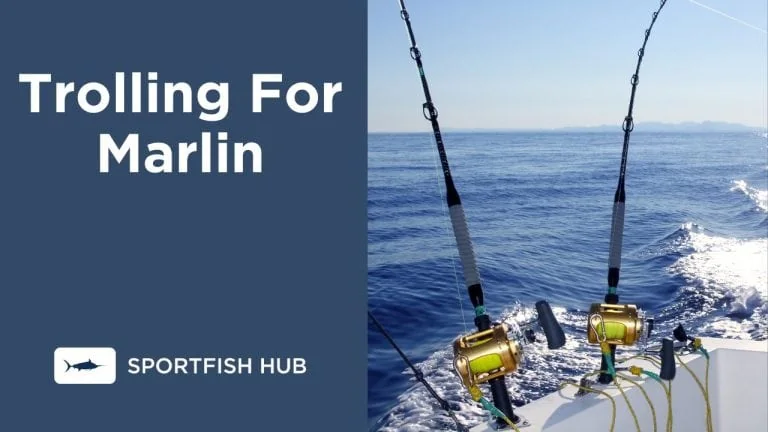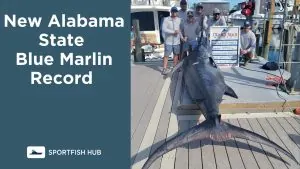Marlin fishing is an exhilarating sport, offering a unique blend of challenge and excitement.
This article delves into the various methods of trolling for marlin, providing a comprehensive guide for both beginners and seasoned anglers. We’ll explore techniques such as trolling with lures, skip baiting, switch baiting, and more. Let’s dive in!
Table of Contents
Trolling with Lures
Trolling with lures is a popular method among marlin anglers., specifically anglers targeting very large Marlin.
See also: The Best Lures For Marlin Fishing.
These artificial lures are designed to mimic the movement and appearance of marlin’s natural prey, effectively attracting these majestic fish.
The lures’ size, shape, and color can vary, allowing for customization based on specific conditions and the type of marlin targeted. Remember, the key to successful lure trolling is to match the lure to the marlin’s preferred prey in your fishing area.
Skip Baiting and Switch Baiting
Skip baiting and switch baiting are advanced techniques that require a bit more skill but can be highly effective.
In skip baiting, a natural baitfish, artificial lure, or teaser is skipped along the water surface, creating a disturbance that piques the marlin’s interest.
Once the marlin follows the bait, a switch is made to a hook bait (Usually on another rod that was prepped and waiting in a holder)
This technique is known as switch baiting and can be particularly effective when marlin are being finicky or cautious.
Mixed Spread of Lures and Baits
For those looking for flexibility in their trolling strategy, using a mixed spread of lures and baits can be an excellent approach.
This method combines the visual appeal of artificial lures with the scent and taste of natural baits, covering all bases to attract marlin. A mixed spread can be particularly useful in varying conditions, allowing you to adapt your strategy as needed.
See also: Choosing the best color Marlin Lure.
Trolling with Rigged Natural Naked Baits
Trolling with rigged Natural Naked baits (Natural bait with no lure or chugger) is another effective method for marlin fishing.
This technique involves rigging naked baits to a hook and trolling them behind the boat. Rigged baits are often considered the number one method for connecting with billfish, including marlin, due to their natural appeal.
Bump Trolling Live Bait for Marlin
Bump trolling is a specialized technique often used in marlin fishing, particularly when using live bait. This method requires a bit more attention and skill compared to regular trolling, but when executed correctly, it can be highly effective.
Selection of Live Bait
The first step in bump trolling is selecting the right live bait. The choice of bait depends on the type of marlin you’re targeting and their preferred prey in your specific fishing area. Common choices include mackerel, mullet, or Tunas and Bonitos if you are targeting large Marlin.
Rigging the Bait
Once you’ve selected the appropriate bait, it’s time to rig it. The live bait is typically rigged on a circle hook, designed to hook the fish in the corner of the mouth. This reduces the chances of gut hooking and increases the survival rate of released fish. Depending on the type of bait and specific conditions, the bait is usually hooked through the nose or the back.
Setting the Bait
With the bait rigged, it’s set out behind the boat. The distance can vary, but it’s typically far enough back that the bait is outside the boat’s prop wash. This positioning helps to ensure the bait behaves naturally, attracting the attention of marlin.
Bump Trolling
Now comes the “bump” in bump trolling. Instead of maintaining a constant speed, the boat is frequently put in and out of gear, or “bumped”, to vary the speed of the bait. This creates an erratic and natural movement in the bait, which can be more attractive to marlin.
Monitoring and Adjusting
While bump trolling, it’s crucial to constantly monitor the bait and adjust the speed and direction as needed. If a marlin is spotted following the bait, the boat can be taken out of gear to let the bait drop back, often triggering a strike.
Hooking and Fighting the Fish
Once a marlin takes the bait, the angler allows the fish to run with the bait for a few seconds to ensure it has swallowed the bait. Then, the angler sets the hook, and the fight begins.
Bump trolling live bait for marlin is a highly effective method, but it requires patience, skill, and a good understanding of marlin behavior.
Setting Up Your Bait and Lures
To effectively attract marlin, it’s crucial to imitate a school of bait fish. This can be achieved by spreading out your lures across outriggers on both sides of the boat in a staggered manner. Up to seven lures are usually pulled behind the boat to attract the attention of a marlin.
What is the Best Trolling Speed for Marlin
Generally, speeds in the 7-9 knot range are effective when targeting marlin. However, it’s essential to adjust your speed based on the conditions and the marlin’s behavior on any given day.
Scanning the Water
While trolling, it’s essential to keep a keen eye on the water. Marlin often sun themselves near the surface, and spotting one can provide an excellent opportunity to cast a bait in front of them.
Considering Fly Fishing for Marlin
For those looking for an even bigger challenge, fly fishing for marlin is an option. Catching a marlin on a fly rod is a significant achievement and usually requires a team effort, with everyone on board involved.
FAQ
How far behind the boat should I troll?
The typical distance for boats is set from 20ft to 150ft back. The power of your boat is really going to dictate the specific distances that work best.
Should you troll with or against the waves?
When trolling for marlin, it is generally recommended to troll with the waves rather than against them, as this allows for better lure action and reduces the strain on your fishing gear.
How long should my leader be for trolling for Marlin?
When it comes to the leader length for trolling for marlin, it is generally recommended to use a leader ranging from 15 to 30 feet. The specific length within this range can vary based on factors such as water clarity, lure size, and personal preference. However, a commonly used leader length for marlin trolling is around 20 feet. This length provides enough distance between the lure and the mainline, reducing the chances of the fish getting spooked by the boat and increasing the chances of a successful hookup. Additionally, using a longer leader allows for better lure action and reduces the risk of the fish seeing the mainline or any potential connections.
What is the best leader for trolling for Marlin?
The best leader for trolling for marlin is typically a heavy-duty monofilament or fluorocarbon leader. These materials offer the necessary strength, abrasion resistance, and invisibility in the water to handle the powerful strikes and fights that marlin are known for. A leader with a breaking strength between 150 to 300 pounds is commonly used, depending on the size of the marlin species you are targeting.
Conclusion
Marlin fishing is a thrilling sport that requires knowledge, skill, and patience. Whether you’re trolling with lures, using natural bait, or even fly fishing, each method has its unique advantages.












